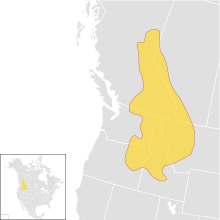Columbian ground squirrel
| Columbian ground squirrel | |
|---|---|
 |
|
| Columbian ground squirrel in Alberta, Canada | |
| Scientific classification | |
| Kingdom: | Animalia |
| Phylum: | Chordata |
| Class: | Mammalia |
| Order: | Rodentia |
| Family: | Sciuridae |
| Genus: | Urocitellus |
| Species: | U. columbianus |
| Binomial name | |
|
Urocitellus columbianus (Ord, 1815) |
|
 |
|
| Distribution of the Columbian ground squirrel | |
| Synonyms | |
|
List
|
|
The Columbian ground squirrel (Urocitellus columbianus), is a species of rodent common in certain regions of Canada and the northwestern United States. It is the second largest member of the genus Urocitellus, which is part of the tribe Marmotini, along with marmots, chipmunks, prairie dogs, and other holarctic ground squirrels. They are stout, with short dense fur, which is characteristically tawny across the bridge of the nose. Social encounters often are initiated with kissing behavior and the most common activity above ground is standing at attention. Residing in mountainous terrain and high plains in northern latitudes, they hibernate most of the year in underground burrows, which may be used for many years. They are emaciated when emerging in the spring. These long periods of torpor earned the squirrels the moniker "Seven Sleepers", since the rests last around seven months. The Columbian ground squirrel came to the attention of the scientific community through writings produced by Lewis and Clark, while 21st century molecular genetics has more finely illuminated its ties with other close relatives.
The Columbian ground squirrel is one of the largest members of the genus, the largest being the Arctic ground squirrel. They have a relatively sturdy, robust build. They measure 325–410 mm (12.8–16.1 in) in length overall, with a tail measuring 80–116 mm (3.1–4.6 in). The hind feet measure 47–57 mm (1.9–2.2 in) and the ear 16–22.5 mm (0.63–0.89 in).
The hair is dense and relatively short. The facial fur is bronze across the bridge of the nose. The fur along the back, legs, and feet is a more cinnamon buff, with darker fur closer to the body. There is a pale beige to buff ring of fur around the eye. The neck fur is gray along the sides of the cheeks. The flanks may be light beige or gray. They have a darker tail, with darker underfur and some lighter beige markings above and dark to grayish white below.Molting occurs diffusely, without a clear line of delineation.
Two subspecies have been described, which vary in appearance. Compared with U. c. columbianus, the population U. c. ruficaudus has a tail more rufous and less gray above. The sides of the face and throat are also more deeply rust shaded. The legs and feet are darker as well. The skull of U. c. ruficaudus is broader, with more robust zygomatic arches.
...
Wikipedia

